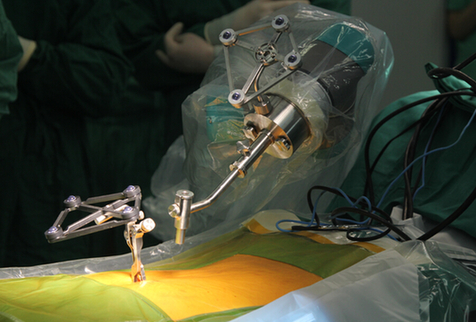Jishuitan Hospital breaks through the world's surgical surgery "forbidden zone" China's independent research and development of surgical robots
August 14, 2015 Source: Xinhuanet
Window._bd_share_config={ "common":{ "bdSnsKey":{ },"bdText":"","bdMini":"2","bdMiniList":false,"bdPic":"","bdStyle":" 0","bdSize":"16"},"share":{ }};with(document)0[(getElementsByTagName('head')[0]||body).appendChild(createElement('script')) .src='http://bdimg.share.baidu.com/static/api/js/share.js?v=89860593.js?cdnversion='+~(-new Date()/36e5)];Using the real-time 3D imagery of China's self-developed real-time 3D imagery, the error is less than 1 mm. Professor Tian Wei, Dean of Beijing Jishuitan Hospital and his team successfully challenged the “forbidden zone†in the field of spinal surgery in the world – it was hailed as “ Upper cervical deformity surgery in the life center.

The picture shows the real-time three-dimensional image orthopedic surgery robot independently developed by China.
On August 12th, Professor Tian Wei and his team once again refreshed the new height of robot-assisted surgery. Using the robot-assisted system, the world's first atlantoaxial vertebra was successfully implemented for a patient with complicated upper cervical deformity and skull base depression. Arthroscopic screw internal fixation has conquered the most complicated surgery in the field of spinal surgery.
In the previous week, Professor Tian Wei and his team successfully completed the world's first minimally invasive internal fixation for robotic-assisted spinal thoracolumbar fractures based on intraoperative real-time three-dimensional images, using a self-developed orthopedic surgery robot. Patients with body fractures were percutaneously implanted with 6 pedicle screws. The patient's fracture reduction effect was ideal, fixed and stable, less soft tissue injury during operation, small surgical incision, high safety, and the patient resumed normal walking on the second day after surgery.
It is reported that this surgical robot system is independently researched and developed by the research team led by Professor Tian Wei, and has completely independent property rights. It is a Chinese-made product in the true sense. For the first time in the world, the system has realized the precise positioning of robots based on intraoperative real-time 3D images with an error of less than 1 mm and the performance index has reached the international leading level.
The surgical robot is designed by a doctor from a clinical perspective and is highly practical. High degree of freedom, good repeatability, advanced biomimetic configuration to ensure the flexibility and stability of the system, comprehensive safety protection mechanism to ensure safe operation of the robot, not only help the doctor to complete the planning of the surgical path, but also to accurately guide the inside Plant implantation significantly reduces the incidence of intraoperative and postoperative complications and significantly reduces intraoperative radiation exposure.
The surgical robot positioning system independently developed by China is still a "all-rounder". Tian Wei said that this robot system with high-tech and high-tech technology can be said to be a multi-indication orthopedic surgery platform. In addition to pedicle screw fixation, the system can also be used for percutaneous iliac screws, percutaneous acetabular anterior column screws, and posterior column screws for internal fixation. The robot has been successfully applied to the complex upper cervical deformity, which is widely recognized as a difficult operation, which proves the safety and accuracy of the system.
It is understood that as a pioneer and practitioner of the clinical application of computer-assisted orthopedics in China, Professor Tian Wei has long been engaged in the research of intelligent orthopedic surgery for image navigation and robot-assisted technology. It is forward-looking that intelligent orthopedic surgery is an important development for orthopedic treatment in the future. direction. Since 2002, he has led a team of orthopedics in Beijing Jishuitan Hospital. From a clinical perspective, he has teamed up with Beijing University of Aeronautics and Astronautics, Beijing Tianzhihang Medical Technology Co., Ltd. and the Shenzhen Institute of Advanced Technology of the Chinese Academy of Sciences. The concept of assisted spinal surgery minimally invasive surgery (CAMISS) developed a series of orthopedic surgical robots, perfected and standardized the clinical application of image navigation, and created an intelligent orthopedic surgery system with image navigation and robotics as the core. The system realizes the minimally invasive surgery of conventional surgery, the safety of complex surgery, and the intelligent operation of key operations. It is a revolutionary advancement in the history of orthopedic surgery. It promotes the era of orthopedics entering a new era of intelligent assisted precision and enhances the comprehensive treatment level of orthopedics. Has important practical significance.
Digital 60m short range laser rangefinder is a laser measurement device which is supposed to replace tape measure, ruler, and other traditional length meauring tool. Laser ruler as its name, it is a electronic ruler which user laser to measure distance.
Our laser measurer has Multiply fuctions:
1. Height measure & Length measure &Distance measure
2. Area Measure
3. Volume Measure
4. Pythagorean Measure
60M Laser Measure,60M Laser Distance Measure,Laser Distance Measure Oem,60M Digitial Laser Distance Measure
Chengdu JRT Meter Technology Co., Ltd , https://www.infrareddistancesensor.com